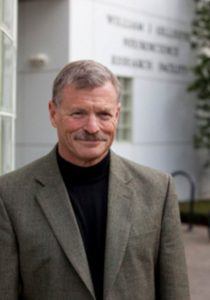
Dr. Oswald Steward
Dr. Oswald Steward is the director of the Reeve-Irvine Research Center (RIRC) (www.reeve.uci.edu) at the University of California, Irvine . The center has been developed to study spinal cord injury (SCI) research and disorders that result from spinal cord injuries.
The center was set up in the 1990s through a donation from Mrs. Joan Irvine Smith, the granddaughter of James Irvine. Mrs. Smith greatly respected the actor Christopher Reeve and the way he dealt with his spinal cord injury – not blaming his horse for causing the accident that resulted in his injury.
Today, organizations like Cure Medical help fund spinal cord injury research projects at the RIRC, including those that Dr. Steward is overseeing.
Dr. Os – thank you for being with us today! Can you help us understand the draw of being a medical researcher?
Steward: I love the ability to discover things new breakthroughs in medicine. Every day I come into the lab we may discover something – little or big – that actually may improve the lives of people. I think this is a wonderful life, and I love every minute of it.
What is the Reeve-Irvine Research Center currently working on?
 Steward: A number of people in our center are working on various projects related to spinal cord injuries. Personally, I’m studying different ways to induce the regeneration of connections that are broken or interrupted after a spinal cord injury. We’ve discovered that deleting a gene called PTEN is a very powerful stimulus for nerve cells that makes them regenerate connections to spinal cord injuries and other types of injuries.
Steward: A number of people in our center are working on various projects related to spinal cord injuries. Personally, I’m studying different ways to induce the regeneration of connections that are broken or interrupted after a spinal cord injury. We’ve discovered that deleting a gene called PTEN is a very powerful stimulus for nerve cells that makes them regenerate connections to spinal cord injuries and other types of injuries.
We’re trying to develop ways to actually translate that ability in animal experimentation in hopes that the experimentation will lead us to a potential treatment for human beings. PTEN is an enzyme that’s a protein molecule. It’s a key regulator of pathways in cells that actually govern growth of cells in general. PTEN regulates the pathway called akt/mTOR.
If we can enable regeneration, then we’ll be able to reverse paralysis. The loss of these connections from the brain into the spinal cord is the reason people become paralyzed.
So when someone has a spinal cord injury, that injury is much like cutting a phone line from the person’s brain to the rest of his body, right?
Steward: That’s exactly right.
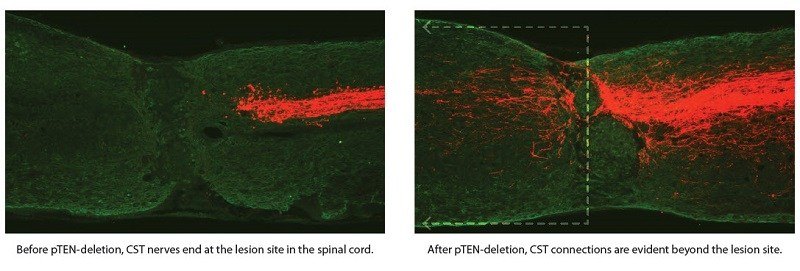 Why are you working on the enzyme PTEN when there’s been so much publicity and a lot of hope invested in using stem cells to regenerate the connections between the brain and the spinal cord?
Why are you working on the enzyme PTEN when there’s been so much publicity and a lot of hope invested in using stem cells to regenerate the connections between the brain and the spinal cord?
Steward: Stem cells, at least so far, haven’t shown the ability to regenerate the connections that are responsible for movement or for a person’s ability to feel. Stem cells can do other things that are potentially important.
Paralysis is viewed as the cutting of the connections from the brain to the spinal cord. So, the only way to reverse paralysis is to re-grow or regenerate those connections. That’s why we’re working on PTEN instead of studying stem cells.
Why did you decide to focus on this type of research, and why are you going down this particular path?
Steward: In general, I’ve always been interested in the way the brain and the spinal cord respond to injury and how the brain repairs itself and enables recovery. I’ve been interested in this subject in many different contexts. In point of view of the spinal cord, we think there’s a real opportunity here. We know what connections we need to re-grow, and we now finally have a way to make that happen, at least in experimental animals.
What does your research tend to indicate currently?
Steward: Basically that we can re-grow connections by deleting PTEN. Doing this enables or contributes to recovery from paralysis, and then we may have ways that actually develop this research into a human treatment. There’s a path there that looks like a reasonable path to accomplish this goal.
What kind of success have you had with animals using this type of treatment?
Steward: We’ve been able to achieve great improvement in the animals’ ability to use their hands in rats and mice. For people with an injury in the neck at the cervical level, we believe there’s a lot of promise.

Laboratory experiments have been able to achieve great improvement in the animals’ ability to use their hands.
The most important thing that concerns most people with spinal cord injuries is the ability to regain the use of their hands.
If you can use your hands, you can take care of your daily life activities. You can eat, you can drink, you can drive, you can take care of yourself, and you can transfer to and from a wheelchair.
If you can’t use your hands and arms, you have to have an attendant at all times. For people with an injury to the neck at the cervical level, the recovery of the ability to use their hands is a huge accomplishment. So, this is where we’re focusing.

Dr. Oswald Steward Speaks on Breaking the Regeneration Barrier
If you can solve the problem of regaining function to the hands and the arms, is it fair to assume that there may be a possibility of using this same research and development to possibly reconnect the brain to the rest of the body and recover other functions?
Steward: It certainly is! Absolutely!! We’re focusing on the hands because that’s a target we can measure on how well this type of treatment is working. We can see the physical results of how this research helps people regain that function. We certainly hope that PTEN research will apply to the entire body.
If you can look into a crystal ball, when in the future do you think this PTEN research may be able to help get function back to someone’s hands with a cervical level injury?
Steward: That’s a really, really hard question to answer. We are to a point where we see a path to where we’ll be able to get to a point of conducting clinical trials – human experiments. But the path from human experiments to kind of the final thing – having a treatment to re-grow the pathway from the brain to the spinal cord really depends on what happens – what we learn and what happens financially for our work in those clinical trials.
How far do you think your research is from clinical trials?
Steward: Holding clinical trials depends on the funding we receive to continue and expand our research. In other words, it depends on how much gas we have in the tank to continue to move forward. We can go fast and do these experiments in a couple of years. If the funding is trickling in for our research and testing, we’ll need more than a couple of years.
Funding for the Reeve-Irvine Research Center’s Spinal Cord Research, thanks to Cure Medical
How and why did Cure Medical get involved as a company with your research?
Steward: The person we’ve been working with at Cure Medical and our very good friend is Bob Yant, the founder of Cure Medical. Bob Yant became interested in our project many years ago, and he and I have been friends for more than 20 years.
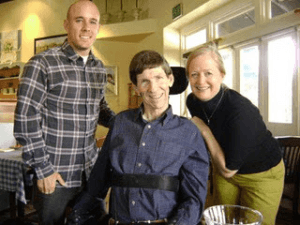
Cure Medical founder Bob Yant is a C4/5 quadriplegic and actively engaged in the SCI research community.
Bob recognized early on what was important – determining where to start searching for answers on how to possibly get back function for spinal cord injuries. Even before Bob started working with me and the Reeve-Irvine Research Center, he had asked all the top scientists involved in spinal cord research what would be the most important to do. They all answered, “grow this pathway in the brain called the corticospinal tract.”
This corticospinal tract is what controls our ability to move. It’s damage to that pathway that causes paralysis.
Everybody agreed that re-growing that pathway would be the single thing that needed to be studied first. Bob and I talked about this type of research. I was one of the people Bob interviewed about 15 years ago who said that growing this pathway was most important when we first started talking about it.
We discovered that someone in the world had achieved that grown this type of pathway – my collaborator, Zhigang He. He is at the Boston Children’s Hospital. He had published a scientific paper on an experiment that he had done pointing out the possibility that he had achieved this type of regeneration – creating the pathway from the brain to the spinal cord. In fact, he showed for the first time in history that regenerating this corticospinal tract was possible.
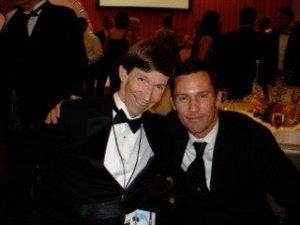
Bob Yant has been an active fundraiser for SCI research for more than 20 years.
I called Bob and asked him if he was still interested in the possibility of regenerating the corticospinal tract. Bob answered, “Oh my gosh, yes.” I told him I thought we’d finally achieved regeneration of the corticospinal tract. That conversation was the beginning of Bob’s working very, very hard to raise money to support the research. We’ve had very generous donations from Cure Medical.
Bob Yant, founder of Cure Medical – a leading manufacturer of intermittent catheters is a quadriplegic himself.
Bob’s personal commitment to finding a cure for spinal cord injury is the reason why Cure Medical donates 10% of all net profits to funding SCI research. Cure Medical is the only intermittent catheter manufacturer to support SCI research with this level of financial commitment.

Cure Catheters work like any traditional intermittent catheter. There’s no need to learn a new routine.
Benefit from the Cure Commitment to research
When you choose to use a Cure Catheter, you’re helping to advance medical research in pursuit of a cure for urinary retention and paralysis! Let us send you a free sample today.
We’re confident you’ll want to join us in making a difference and funding research for a cure.
 To request free samples of the Cure Catheter® or any Cure Medical catheter, contact your local distributor of quality healthcare products, or click here.
To request free samples of the Cure Catheter® or any Cure Medical catheter, contact your local distributor of quality healthcare products, or click here.
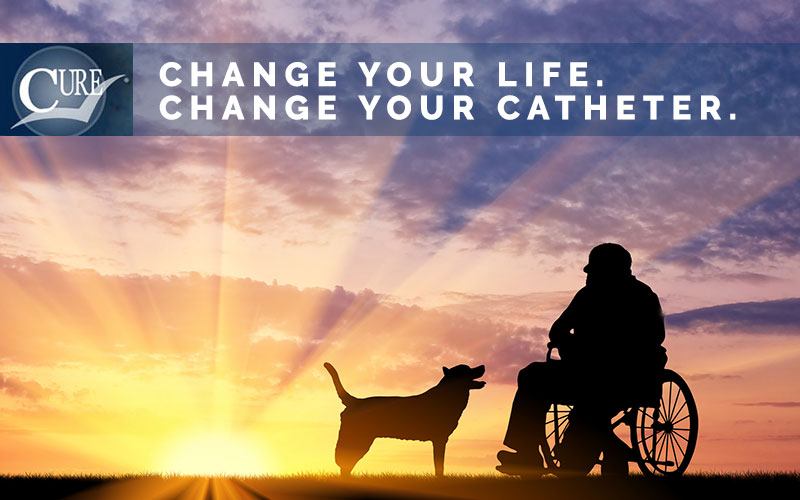
How important to your research is gaining more outside funding?
Steward: In general, the federal government supports what we call basic science or discovery research. The federal government wants innovative things –new things – discovered. We’re at the early stage with our research to get enough money to try to apply for some of these federal grants.
But second and even more important is we’re at a point where we’re beyond the basic discovery in our research and are trying to take regenerating the corticospinal tract from science to a treatment that doctors can actually use as a treatment for spinal cord injuries to rebuild the corticospinal tract.
This process is called translation where we translate the science into a treatment that will help us to continue to study how to better repair the spinal cord. This is absolutely the most difficult money to get from anybody to reach the next level of our research. That’s why our private donations like the money we receive from Cure Medical are so terribly important.
In other words, you’ve proven, at least in laboratory animals, that you can re-grow this pathway from the brain to the spinal cord to increase function in arms and hands.
Now that you have proven you can do this with laboratory animals, obtaining the funding to take this research from helping laboratory animals and implementing it into a treatment for people with spinal cord injuries is the most difficult funding to get. Is this the reason your researchers need more money from the private sector to move this new technology forward?
Steward: Exactly.

So, the faster you can get funding to continue the research, the closer we’ll be to testing this research with people with spinal cord injuries.
Steward: That’s exactly right.
If someone wants to contribute to your research or learn more about your progress in this area, how do they contact you?
Steward: Interested people can go to our website www.reeve.uci.edu. You’ll be able to read about some of the projects happening and learn some of the ways our scientists are working on these projects. You’ll also be able to find information on our public education programs and our outreach programs.
For instance, we’re doing a public education program on March 14. People from all over the country will be in attendance. This program will be conducted at the University of California, Irvine. To attend this program and get more information about what will be presented, go to our website. We’ll try to video at least part of this program, and we hope to be able to post those videos on our website after the event.
Is there anything else that we can do to help you and your program?
Steward: Yes, there is, if you’ll let people know that there is hope out there for them in the research we’re doing, and in the research we hope to do in the future. For the first time in the history of spinal cord research, there are things information and research coming online and being developed for spinal cord injuries and other disorders.
Let them know that all research, but this research in particular, needs additional funding, both in terms of private donations and in terms of talking to legislators and discussing the importance of this research. This type of action is what brings cures.
How do people learn how to talk to legislators and bring public awareness to the research being done by the Reeve-Irvine Research Center and other scientists who are working on cures for spinal cord injuries?
Steward: You can find out from organizations like Research Now that offers educational information on this subject.

If an individual company, an organization or a charity wants to get involved financially with your organization, how can they obtain information on being a part of this research?
Steward: They can go directly to our website at www.reeve.uci.edu. Click on the button that says Donate Now. Or, they can call Tanya Jope on her cell at 949-633-6626, the Director of Community Development, here at the Reeve-Irvine Research Center. She’s available at all times.
To learn more about Dr. Steward’s research projects and other spinal cord injury research initiatives that are financially supported by Cure Medical, please visit https://www.curemedical.com.
Thank You for Choosing A Cure!
Enjoy Our Free Resources & Articles
 CURE NATION is designed with you in mind, to offer assistance and education when you need it through a personal support program.
CURE NATION is designed with you in mind, to offer assistance and education when you need it through a personal support program.
All of the information you find below and on our related social media pages is meant to guide you to places, topics and, resources that enhance your life, while also connecting you with a growing group of friends.
- Sign up for our free, CURE NATION e-newsletter to have our latest stories delivered directly to you, once a month.
- Get our FREE LIFESTYLE + TRAVEL BOOKS here.
- Have an idea you’d like to share? Let us know.
- Be sure to take a minute to meet our Cure Advocates too.
You may also enjoy:


